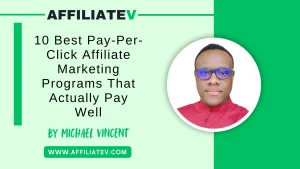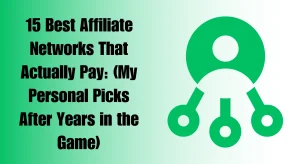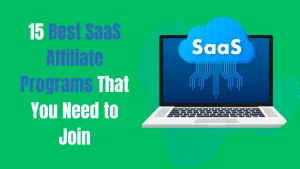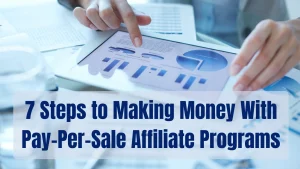What are Affiliate Marketing Programs & How to Choose the Right One for Your Niche
What are affiliate marketing programs? Learn how they work, why they matter, and how to choose the right one for your niche to start earning commissions the smart way.
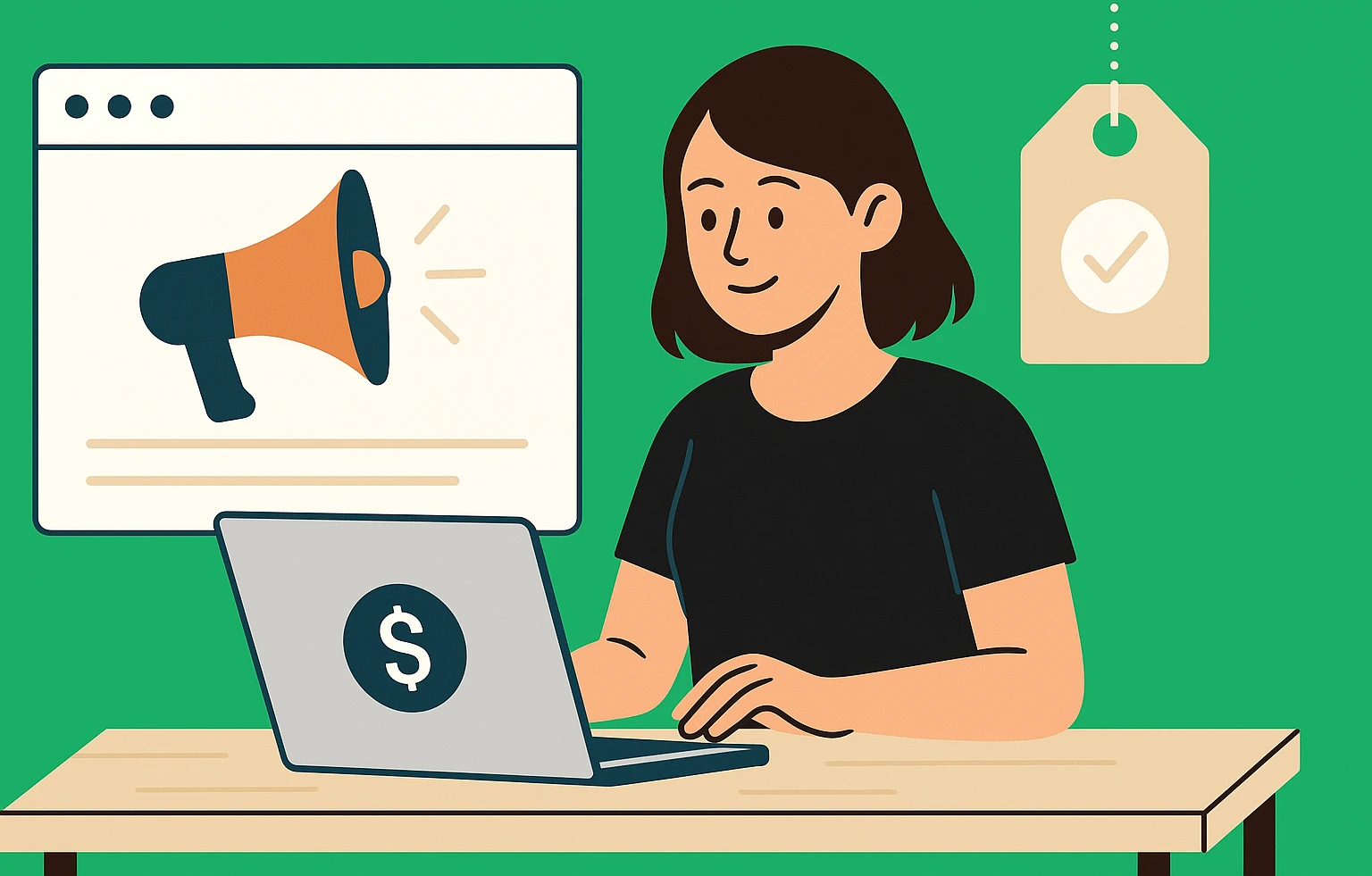
Ever talked about a product online and thought, “I should be getting paid for this”? That’s basically affiliate marketing. You sign up for a program, promote a product using your unique link, and when someone buys through that link—you earn a commission.
Simple in theory. But here’s where most people mess up: they join any program that promises high payouts, without thinking about their niche, audience, or if the product’s even worth promoting.
Not all affiliate programs are created equal. Some look great on the surface but barely convert. Others have bad tracking, delayed payouts, or promote shady stuff that can hurt your reputation.
If you want to earn consistently, you need to choose programs that fit what you do—and what your audience actually wants.
In this guide, I’ll walk you through what affiliate programs really are, what to look for, and how to avoid the common traps that waste time and kill trust. Let’s make sure you’re getting paid for the right clicks.
Key Takeaways
- Affiliate marketing programs let you earn by promoting products with trackable links.
- Not all programs are equal—pick ones that fit your niche and audience.
- Understand the payment model: CPS, CPA, CPL, or recurring.
- Focus on relevance, commission, conversion rate, and trust.
- Avoid chasing high payouts that don’t match your content.
- Use affiliate networks and tools to compare and track offers.
- Start with 1–3 strong programs and test what converts.
What Are Affiliate Marketing Programs?
Affiliate marketing programs are like referral deals—but with real payouts.
You sign up with a company (the merchant), they give you a special tracking link, and when someone buys through that link, you earn a cut. That’s your commission. You’re the affiliate, they’re the merchant, and the link connects it all.
Recommended Reading: How to Apply and Get Approved by Affiliate Programs: A Step-by-Step Guide
So, what are affiliate marketing programs? They’re systems businesses use to let people like you promote their products—and reward you when you help make a sale.
Here’s a simple breakdown:
- Merchant: The company selling the product (like Amazon or a course creator on ClickBank)
- Affiliate: You—the one promoting the product
- Customer: Someone who clicks your link and makes a purchase
- Commission: Your reward for driving that sale
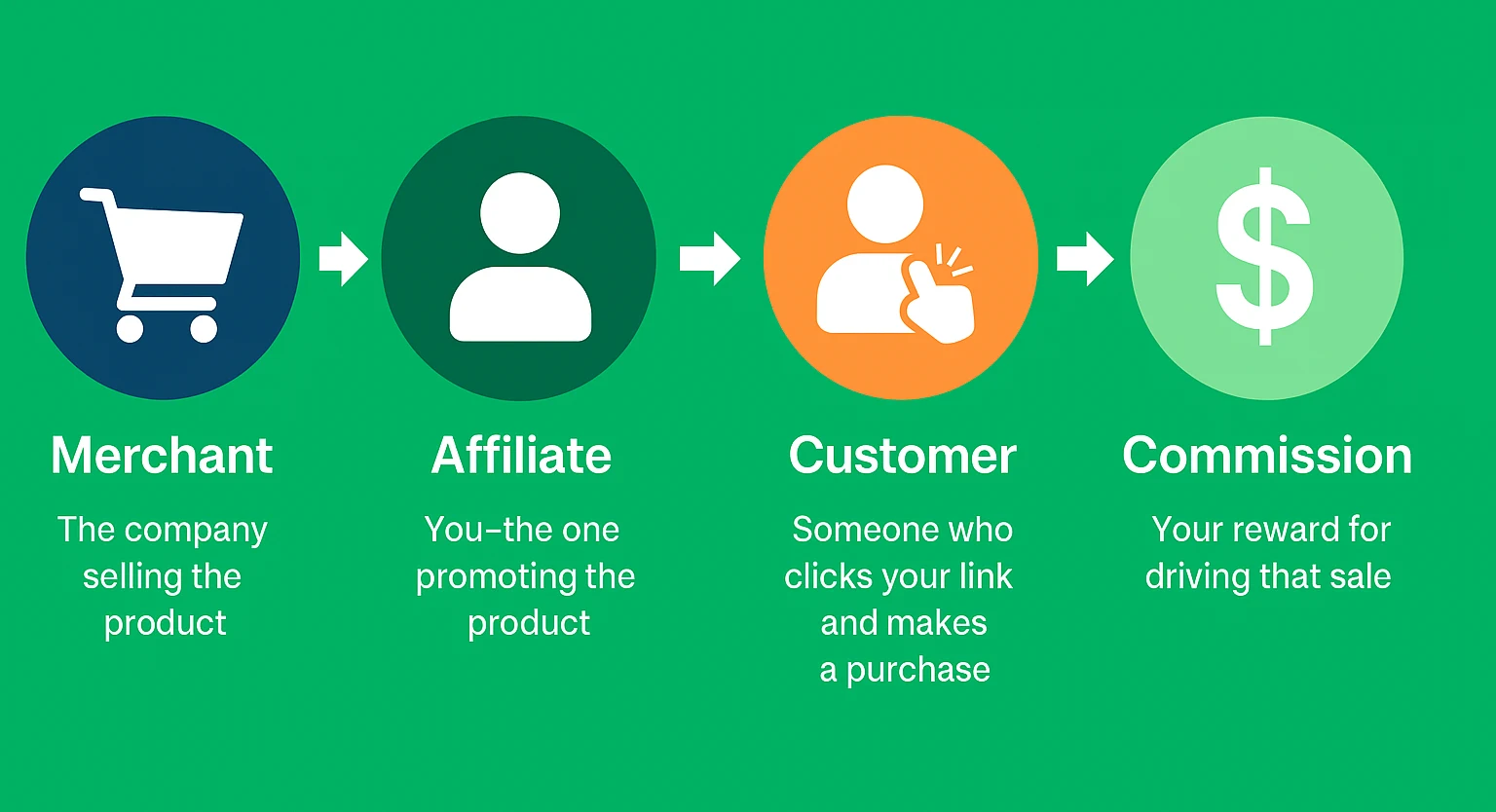
For example:
Let’s say you run a tech blog. You join Amazon’s affiliate program. You write a post reviewing the best wireless headphones. You include your affiliate link to a pair on Amazon.
A reader clicks, buys the headphones—you get paid a percentage of that sale. Amazon handles everything else—shipping, customer support, returns. You just bring in the traffic.
That’s the beauty of affiliate programs: low risk, no inventory, and you can earn passively by recommending stuff you already believe in.
Types of Affiliate Programs
Affiliate programs don’t all work the same way. The way you get paid depends on the type of program. Here are the main ones you’ll run into:
1. CPS – Cost Per Sale
This is the most common affiliate model. You earn a commission only when someone clicks your affiliate link and buys something. Programs like Amazon Associates, ShareASale, and ClickBank use CPS.
If you’re promoting physical products, online courses, or digital downloads, you’ll likely deal with CPS.
Example: You recommend a $100 product. If your commission rate is 10%, you earn $10 for every sale.
Pros and Cons:
| Pros | Cons |
|---|---|
| Higher payouts per conversion | No sale = no money |
| Works well with buyer-intent traffic | Can take time to build trust to convert |
| Simple to track and scale | Relies heavily on good product pages |
2. CPA – Cost Per Action
You earn money when someone takes a specific action—like installing an app, signing up for a free trial, or submitting a form. No need for a full purchase.
This model is popular in niches like finance, gaming, and software.
Example: You promote a budgeting app. If someone signs up for a free trial through your link, you earn $5–$15 even if they never buy the full version.
Pros and Cons:
| Pros | Cons |
|---|---|
| Easier to convert than a sale | Lower payout than CPS |
| Great for high-traffic websites | Quality of leads may affect earnings |
| Fast results—no waiting for purchases | Can attract empty or fake signups |
3. CPL – Cost Per Lead
Similar to CPA, but focused on collecting leads—usually contact info like emails, phone numbers, or business details. Great for niches like B2B, insurance, or real estate.
Example: You promote a free quote form for home insurance. A user fills out the form—you get paid $3 to $50 depending on the offer.
Pros and Cons:
| Pros | Cons |
|---|---|
| Quick commissions, even without sales | Leads may not always be qualified |
| Good for email marketing or funnels | Often lower commission per lead |
| Easier to scale in volume niches | Risk of bots or spam signups |
4. Recurring Commissions (Subscription-Based)
You get paid monthly or annually for as long as the customer stays subscribed. This is common with SaaS tools, memberships, or subscription boxes.
Example: You promote a $30/month email tool. If you get 10 people to sign up and they stay, you’re earning $300/month consistently.
Pros and Cons:
| Pros | Cons |
|---|---|
| Builds steady, passive income | Takes longer to see big earnings |
| Great for SaaS or content creators | Churn (users cancelling) affects pay |
| Easier to project future revenue | Requires ongoing value to keep users |
Each type works best with specific traffic types and content styles. The key is to match the payout model with your audience’s behavior.
Why Choosing the Right Program Matters
Choosing the wrong affiliate program is like promoting winter jackets to people living in the tropics—it won’t convert, no matter how good the product is.
1. Niche fit is everything
Your audience follows you for a reason. If you run a fitness blog, promoting web hosting makes zero sense. But recommending supplements, workout gear, or fitness apps? That lines up. The tighter the fit, the higher the trust—and the better the conversion.
2. Commission rates look good on paper—but they’re not the full story
A 50% commission sounds amazing, but if only 1 in 100 people buys, you won’t make much. Sometimes a lower commission (like 5–10%) on a high-converting product makes you more money. Always look at how well the product sells, not just the payout.
3. The merchant’s reputation affects yours
If their site is shady, the checkout breaks, or the product disappoints, your credibility takes a hit. Promote stuff you’d buy yourself. Do some digging—look at reviews, test the product if you can, and check how they handle support.
4. Look for long-term value
Here’s what matters over time:
- Cookie duration: A 30-day cookie means you still get paid if someone buys later. A 24-hour cookie (like Amazon’s) gives you a short window.
- Reliable payouts: Some networks delay payments or set high thresholds. That messes with your cash flow.
- Support: A responsive affiliate manager or solid dashboard makes your life easier.
The right program doesn’t just pay—it fits your brand, earns trust, and works in the long run.
How to Pick the Right Affiliate Program for Your Niche
You don’t need more programs, you need the right ones. Here’s how to find them.
1. Know Your Audience’s Pain Points
Before picking any program, you need to understand what your audience really needs. What are their challenges? What do they constantly ask about in comments, emails, or on social media? If you’re running a blog about healthy eating, for example, your audience might be looking for meal planning tools, supplements, or healthy cooking gadgets.
Promoting a product unrelated to that—like a tech gadget—will feel off and won’t convert well. The key is to match your affiliate offers with what your audience is genuinely searching for or needs help with.
2. Check Product Relevance and Quality
Once you’ve narrowed down the types of products your audience will find valuable, make sure those products are top-notch. If you’re recommending a product that’s poorly made or has terrible reviews, it’ll damage your credibility. You should always ask yourself:
- Does this product truly solve a problem for my audience?
- Is it something I would personally use or recommend?
- What are the reviews like? Is it trusted by others?
If you can’t stand behind it, don’t promote it. Your reputation is more valuable than any quick commission.
3. Look Into Program Terms and Commission Structure
Now, dig deeper into the program’s terms. Look beyond just the commission rate.
Here’s what you need to check:
- Commission %: How much do you earn per sale? Sometimes, even a 5-10% commission on high-ticket items like courses or software can be more profitable than a 50% payout on a low-cost product.
- Cookie duration: This refers to how long after someone clicks your link you can still earn a commission if they buy. A 30-day cookie means you can still get credit for a sale if they buy within that window. The longer the cookie duration, the better.
- Payout structure: Is there a minimum payout threshold? Some programs may require you to hit $100 in earnings before they’ll pay you. If you’re just starting, this could be tough. You’ll also want to know when and how they pay (via PayPal, bank transfer, etc.).
- Recurring vs. one-time payouts: Recurring commissions (like with subscription-based services) can build long-term income, which is great if you want steady cash flow. One-time commissions are a good option, too, especially if the product has high demand.
4. See What Top Affiliates in Your Niche Promote
Research is key. Look at what successful affiliate marketers in your niche are recommending. Head to their sites, look for affiliate links, or check their social media. See which programs they promote and how they talk about them.
If the top players in your space are consistently promoting a particular product or program, it’s probably worth considering. You can also check out affiliate networks or industry-specific forums to see what’s working for others. If 5-10 reputable affiliates are all backing the same product, it’s a good sign that it’s a strong, trustworthy offer.
Recommended Reading: 8 Main Key Features of a Good Affiliate Program
Quick Checklist:
- Does the product solve a real problem for my audience?
- Is the product high quality and well-reviewed by others?
- Do the program terms, like commission structure and cookie duration, work for my goals?
- Can I trust the merchant and their reputation?
- Are top affiliates in my niche promoting this product?
- Does the commission justify the effort to promote it?
By following these steps, you’ll avoid wasting time on programs that won’t deliver and focus your energy on ones that are aligned with your audience, your niche, and your long-term goals.
Mistakes to Avoid
When you’re diving into affiliate marketing, it’s easy to make some rookie mistakes. Here are the most common ones to watch out for:
1. Jumping on High-Paying Offers with No Niche Fit
It’s tempting to go after programs that promise huge commissions, but if they don’t fit your niche, you’re wasting your time.
For example, if you run a beauty blog, promoting a high-ticket software tool might bring in money, but it won’t resonate with your audience. You’ll struggle to convert, and it could damage your credibility. Stick to offers that align with your content and audience’s interests.
2. Ignoring Program Rules
Every affiliate program has its own set of rules. Some may not allow certain promotional methods, like email marketing or paid ads. Others may have strict guidelines on how you can use their brand name.
Ignoring these rules can get you banned from the program or even from the network. Always read the terms and conditions carefully to ensure you stay compliant.
3. Promoting Too Many Things at Once
Another mistake is spreading yourself too thin by promoting multiple programs at once, especially if they’re not related. It dilutes your focus and confuses your audience.
If you’re promoting a health supplement, a tech gadget, and a business course all at once, your audience might not know what to trust. Stick to promoting a few high-quality, relevant products at a time to maintain focus and trust.
By avoiding these mistakes, you’ll set yourself up for more sustainable, long-term success in affiliate marketing. Focus on what fits, follow the rules, and don’t overcomplicate your offers. Keep it simple and strategic.
Tools to Help You Compare Programs
Finding the right affiliate program can be overwhelming with so many options out there. Thankfully, several tools and resources can help you narrow down your choices and make smarter decisions.
1. Affiliate Networks (ShareASale, CJ, etc.)
Affiliate networks like ShareASale, CJ Affiliate, and Rakuten Marketing bring multiple affiliate programs together under one roof. These platforms make it easy to browse and compare different offers in one place.
You can filter by category, commission rate, and cookie duration, and even check out the program’s performance metrics. They also often provide tracking tools to help you see what’s working for you.
2. Spy Tools or Blogs
Spy tools like Ubersuggest, SEMrush, SimilarWeb, or Affiliatly allow you to research your competitors and see which affiliate programs they are promoting.
You can reverse-engineer their content strategy and spot high-converting offers that work within your niche. Affiliate blogs and websites like NicheHacks or AffiliateFix often highlight successful programs in various niches, providing useful comparisons and real-world results from marketers.
3. Niche Forums and YouTube Channels
Join niche-specific forums or Facebook groups to get real-time feedback from other marketers in your space. These communities often share recommendations on which affiliate programs are performing well.
YouTube channels, too, can be a goldmine—many affiliate marketers post reviews of the programs they use, breaking down the pros and cons in detail. Reddit and Quora are also great places to ask other marketers about their experiences with specific programs.
Using these tools helps you not only find the best programs but also learn from others’ experiences. They can save you time, and help you avoid costly mistakes by giving you insights before you jump into a new offer.
Here’s an Example Breakdown – Fitness Niche
Let’s say you run a blog or YouTube channel focused on home workouts, nutrition tips, and healthy living. You’re attracting people who want to get in shape, stay active, or lose weight without going to a gym.
Here are three affiliate programs you might consider:
1. MyProtein Affiliate Program
- Type: Cost Per Sale (CPS)
- Commission: Up to 8%
- Cookie Duration: 30 days
- What You Promote: Protein powders, supplements, workout gear
- Pros: Huge brand in the fitness space, regular discounts, solid product range
- Cons: Lower commissions compared to digital products
2. Fitbod App Affiliate Program
- Type: CPS + Recurring
- Commission: 50% on initial sale, 30% recurring
- Cookie Duration: 30 days
- What You Promote: AI-powered personal training app
- Pros: High commissions, recurring payouts, digital product (low overhead)
- Cons: May not appeal to older or less tech-savvy audiences
3. Bowflex Affiliate Program (via Commission Junction)
- Type: CPS
- Commission: 3–5% per sale
- Cookie Duration: 30 days
- What You Promote: Home workout machines (treadmills, dumbbells, etc.)
- Pros: High-ticket items, well-known brand
- Cons: Lower conversion rate due to higher price point
Which Is the Better Fit?
If your audience is budget-conscious or prefers quick wins, Fitbod is the strongest option. It’s low-cost, mobile-friendly, and provides a high commission with recurring payouts. That means you earn again each month a user stays subscribed. Plus, digital fitness tools are trending and convert well for younger audiences.
MyProtein is also a solid pick if your content leans more toward nutrition or supplement guides. It may convert better if your traffic includes returning customers or loyal brand fans.
Bowflex, while solid for big purchases, suits content built around gear reviews or high-income audiences ready to invest in premium equipment. It works—but only if your traffic matches that buyer intent.
For most beginner and mid-level fitness affiliates, Fitbod wins in terms of value, ease of promotion, and income potential.
Conclusion
Choosing the right affiliate program isn’t about chasing the highest payout—it’s about finding what fits your niche and audience. When the product matches your content and solves a real problem, conversions feel natural. You’re not just pushing links—you’re helping.
Stick to offers you believe in. Know what your people need. And build trust every time you recommend something.
Got questions? Stuck picking between two programs? Drop a comment or shoot me a message—always happy to help. Or, share what’s working for you. Let’s learn from each other.
Frequently Asked Questions
What are affiliate marketing programs in simple terms?
Affiliate marketing programs are deals between a brand (the merchant) and a promoter (the affiliate—you). You promote a product or service using a unique tracking link. When someone buys through your link, you earn a commission. It’s that simple. The brand handles the product, delivery, and customer support. You focus on getting clicks and conversions. For example, Amazon’s affiliate program lets you earn by linking to books, gadgets, or household items. There are thousands of programs across every niche—tech, fitness, fashion, finance. The goal is to promote what fits your audience best and helps them take action.
How do I find affiliate programs for my niche?
Start with affiliate networks like ShareASale, CJ, or Impact. You can search by category and see commission rates, cookie duration, and payout terms. Google helps too—just search “your niche + affiliate program.” For example, “vegan cooking affiliate programs” brings up dozens of options. Also, check what similar creators or bloggers are promoting. Tools like SimilarWeb or Ubersuggest can help you spy on competitor links. Lastly, don’t ignore Facebook groups, Reddit threads, or YouTube channels in your niche—people often share hidden gems there.
Are affiliate programs free to join?
Yes, the legit ones are always free. If a program asks for money upfront, that’s a red flag. Real affiliate programs make money when you make sales, not the other way around. Networks like Amazon Associates, ClickBank, or Rakuten let you sign up, get links, and start promoting without any fees. Some high-end programs may require you to apply or show traffic stats, but you’ll never be asked to pay to join. Be careful with paid “affiliate systems” that promise overnight results—they’re often just shiny sales funnels with no real product behind them.
Which affiliate program type is best—CPS, CPA, or recurring?
Each has its place, but it depends on your audience and strategy. CPS (cost per sale) pays only when someone buys. It works well for product reviews or tutorial-style content. CPA (cost per action) can pay faster since users just need to sign up or fill a form—it’s great for lead gen. Recurring commissions are ideal if you’re promoting tools or subscriptions. You earn monthly as long as the user stays. If you’re building long-term passive income, recurring wins. If you want fast cash from volume, CPA or CPS may work better.
How do I know if a program is worth promoting?
Look at four things: product relevance, commission structure, brand trust, and support. If the product fits your content and solves a real problem, it’s worth testing. Check the commission rate—but also cookie duration. A 30% payout sounds great, but if the cookie lasts 24 hours, you might miss sales. Is the brand legit and known? A shady-looking product won’t convert, no matter the rate. Finally, good affiliate programs offer tools, support, and clear reporting. If you’re left guessing how to track your clicks or earnings, it’s a sign to look elsewhere.



